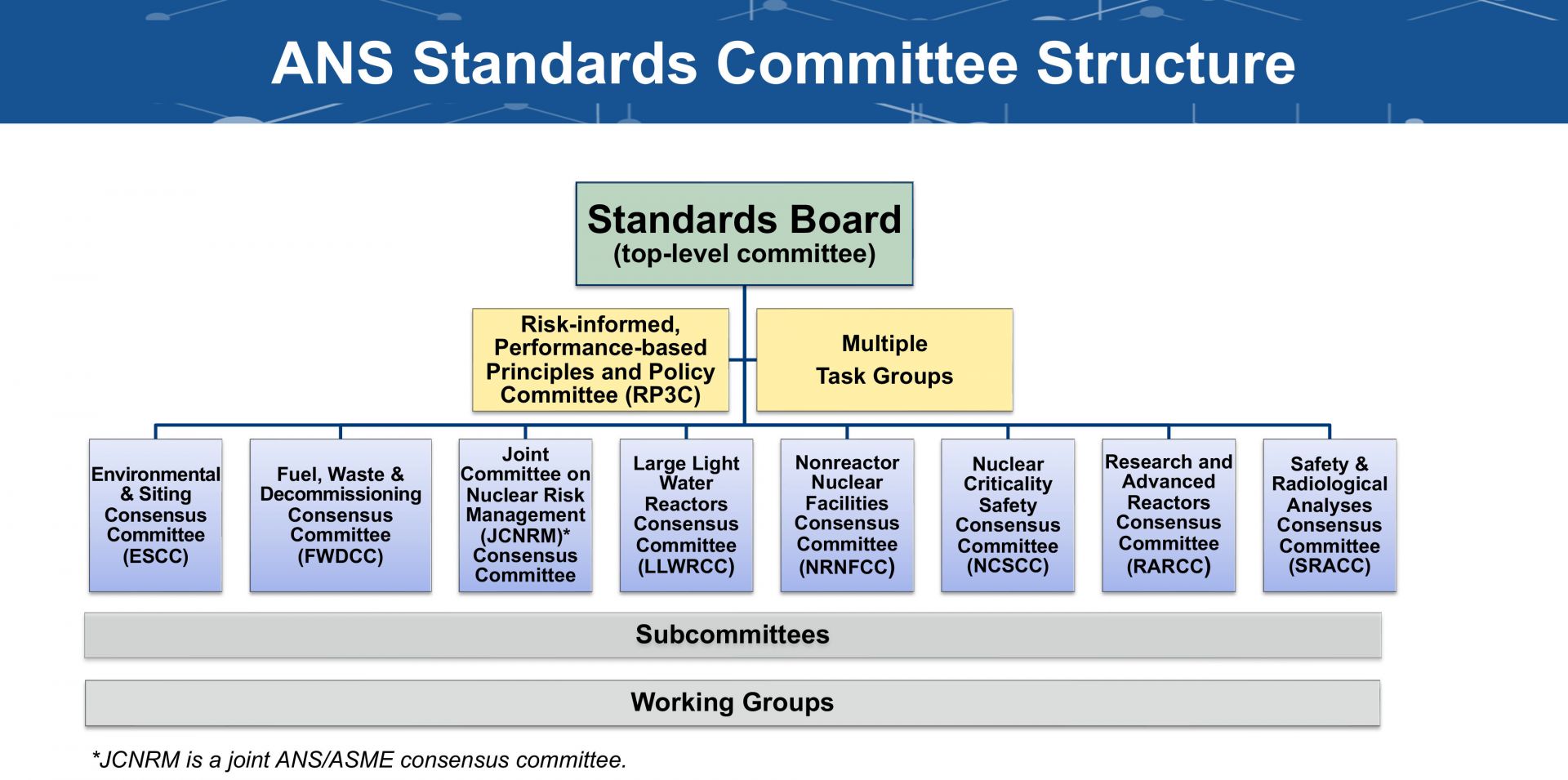Bringing 2022 ANS Standards Committee successes into the new year
By all accounts, 2022 brought many successes for the American Nuclear Society’s Standards Committee, including the initiation of five projects, reaffirmation of 11 current standards, and publication of seven new or revised standards. The entire collection of ANS current standards has been approved or reaffirmed (reapproved without change) by the American National Standards Institute (ANSI) within the past five years, keeping ANS in 100 percent compliance with ANSI’s requirement on maintaining current American National Standards. Also, the ANS standards program was reaccredited by ANSI on August 19, 2022, with the approval of a revised set of rules and procedures. ANS’s new rules and procedures take advantage of the opportunity to develop standards-related technical reports that may be registered with ANSI.
There's more: In addition, staff for ANS standards completed an administrative action in 2022: an archive of 200 ANS standards dating back to 1964 have now been digitized and made available in our partnered standards store with Techstreet. Making all ANS standards available in the ANS store provides users with complete version histories and makes these documents available if needed for historical reference.
In a similar effort to increase the visibility of ANS standards, this year ANS will work with publisher Elsevier to index ANS standards in its Engineering Village platform, specifically in its Compendex database. Engineering Village is a search-and-discovery platform that provides high-quality content, data, and intelligence needed to answer engineering questions. ANS standards will be added to the collection of other ANS publications already included in the Compendex database. Compendex will include only the basic details of ANS standards, such as title, scope, and keywords. Subscribers to Engineering Village will be directed to ANS’s partnered store to acquire the full-text document.
High-impact highlights: Arguably two of the year’s most significant accomplishments were the approval and publication of two highly anticipated standards: ANSI/ASME/ANS RA-S-1.1-2022, Standard for Level 1/Large Early Release Frequency Probabilistic Risk Assessment for Nuclear Power Plant Applications and ANSI/ANS-30.3-2022, Light Water Reactor Risk-Informed, Performance-Based Design.
ANSI/ASME/ANS RA-S-1.1-2022 is a joint standard developed with the American Society of Mechanical Engineers by the ANS/ASME Joint Committee on Nuclear Risk Management. The 2022 edition is a substantial revision of ASME/ANS RA-Sb-2013, Addenda to ASME/ANS RA-S-2008. This edition provides greater consistency among technical elements, and other changes include:
- addition of back references from part to part to facilitate the peer review process;
- removal of Capability Category III;
- addition of a new section to assess the technical adequacy of newly developed methods;
- removal of “PRA maintenance” and “PRA upgrades” examples now addressed by the Pressurized Water Reactor Owners Group;
- addition of a new appendix that provides the meanings of action verbs used in requirements;
- deletion of Part 10 on seismic margin assessment.
The previous version of the RA-S standard is endorsed in U.S. Nuclear Regulatory Commission Regulatory Guide 1.200 (Rev. 3), “Acceptability of Probabilistic Risk Assessment Results for Risk-Informed Activities.” ANSI/ASME/ANS RA-S-1.1-2022 was issued in May 2022. ANS expects NRC endorsement of ANSI/ASME/ANS RA-S-1.1-2022 in the next revision of RG 1.200.
An impactful addition: Issued in July 2022, ANSI/ANS-30.3-2022 is a new standard developed under the ANS Large Light Water Reactor Consensus Committee. This standard provides requirements for the incorporation of risk-informed, performance-based (RIPB) principles and methods into the nuclear safety design of commercial light water reactors. The standard establishes a minimum set of process requirements the designer must follow to meet the intent of this standard and to appropriately combine deterministic, probabilistic, and performance-based methods during design development. This standard provides requirements for using RIPB methods to support (1) definition of safety requirements; (2) licensing-basis event selection; (3) design-basis safety analysis; (4) probabilistic risk assessments; (5) severe accident analysis; (6) classification and categorization of structures, systems, and components; (7) systematic defense-in-depth evaluations; and (8) performance-based decision analysis.
A commercially viable advanced reactor is already using ANSI/ANS-30.3-2022 to significant benefit. The issuance of this standard is considered an important achievement because it is the first voluntary consensus standard that formally incorporates performance-based decision-making. Although the title refers to LWRs, most of ANSI/ANS-30.3-2022 is technology inclusive. This standard is currently under review by the NRC for endorsement.
 Standards program organization: The ANS Standards Committee includes more than 150 committees in a multitiered organizational structure (see chart). A challenge encountered with having so many committees is finding volunteers with relevant expertise and interest to staff these committees. To address this, last year ANS launched the Standards Committee Volunteer Database as a new tool to help especially with filling out working groups. Standards development starts with working groups—the writers of ANS standards. Working groups in a related topical area are assigned to a subcommittee. Subcommittees are created by and overseen by consensus committees with a related but broader topical area. Consensus committees report directly to the ANS Standards Board—the top-level ANS standards committee. The Standards Board may establish special committees and task groups as needed. Together, all of these committees comprise the ANS Standards Committee and work together to develop, maintain, and manage the ANS standards program.
Standards program organization: The ANS Standards Committee includes more than 150 committees in a multitiered organizational structure (see chart). A challenge encountered with having so many committees is finding volunteers with relevant expertise and interest to staff these committees. To address this, last year ANS launched the Standards Committee Volunteer Database as a new tool to help especially with filling out working groups. Standards development starts with working groups—the writers of ANS standards. Working groups in a related topical area are assigned to a subcommittee. Subcommittees are created by and overseen by consensus committees with a related but broader topical area. Consensus committees report directly to the ANS Standards Board—the top-level ANS standards committee. The Standards Board may establish special committees and task groups as needed. Together, all of these committees comprise the ANS Standards Committee and work together to develop, maintain, and manage the ANS standards program.
Importance of RIPB: As an example of a special committee, the ANS Standards Board about 10 years ago created the Risk-informed Performance-based Principles and Policy Committee (RP3C). The RP3C had a very productive 2022, including successes like the issuance of a much more mature guidance document to aid working groups in incorporating RIPB methods into ANS standards. The guidance document, issued in April 2022, is titled “Incorporating Risk-Informed and Performance-Based Approaches/Attributes in ANS Standards.” Training on the use of the guidance document began last year and will be continued in 2023. In addition, RP3C hosts an RIPB Community of Practice (CoP), which held 10 presentations in 2022. An archive of 30 CoP recordings is available as an RIPB knowledge database on RP3C’s webpage. This valuable resource is quite popular—one of the recordings has nearly 2000 views—and so look into it if you haven’t yet.
Your help needed: As active as 2022 was for ANS standards, the program seeks to continue that momentum into 2023 with new and ongoing efforts. Volunteers are always needed, and time commitment levels can be very low. Please contact standards@ans.org for more information about the status of the projects mentioned here or for information about how to become involved in ANS standards.
Pat Schroder is the Standards manager for the American Nuclear Society.



